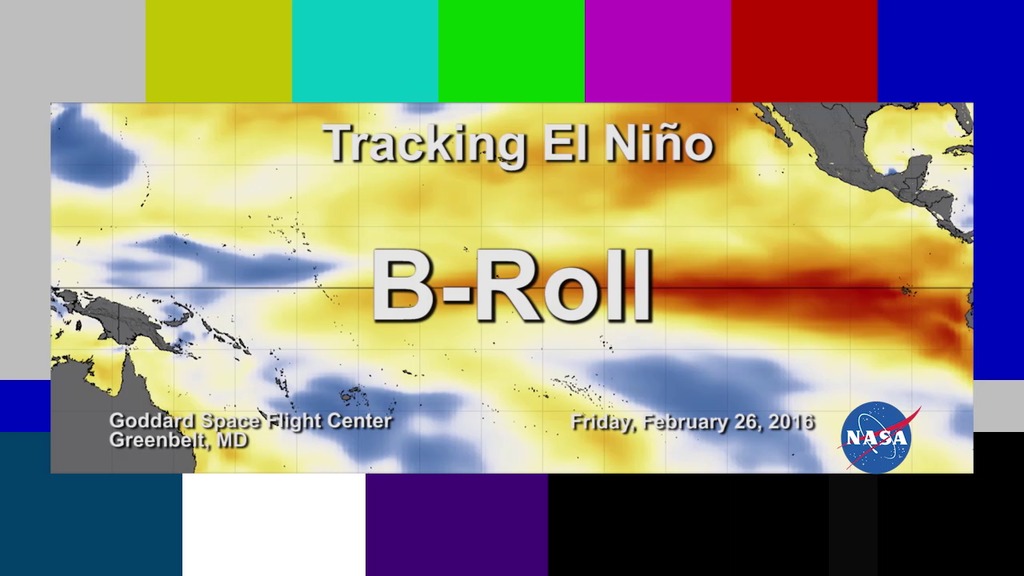2015 El Niño Disrupts Ocean Chlorophyll
Sea Surface Temperature Anomaly & Ocean Color variations during El Nino vs. La Nina, using the rainbow colorbar for Ocean Color
These images compare monthly sea surface temperature anomalies (SSTA) and surface chlorophyll concentrations during El Niño (Dec. 2015) and La Niña (Dec. 1999). The SSTA images are derived from NOAA Optimum Interpolation Sea Surface Temperature (OISST) data, while the chlorophyll images are derived using MODIS (El Niño) and SeaWiFS (La Niña) data.
With the onset of El Niño, a drop in air pressure over the equatorial eastern Pacific causes the trade winds to weaken and sometimes even reverse, driving warm water eastward, towards South America. Below the ocean’s surface, the eastward migration of the warm pool deepens the thermocline and curtails the usual upwelling of deep-water nutrients to the surface, causing declining concentrations of surface chlorophyll, the green pigment that indicates the presence of phytoplankton. The opposite phase, La Niña, is characterized by strong trade winds, which causes upwelling to intensify. Cold, upwelled waters have more nutrients than the warmer surface waters; therefore, more intense upwelling coincides with higher chlorophyll and phytoplankton concentrations.
During the 1997-98 El Niño, there were large population declines within the eastern Pacific marine food web. However, the strong La Niña that followed in 1998–99 had the opposite impact: stronger east-to-west trade winds that increased nutrient upwelling and fertilized one of the biggest phytoplankton blooms detected in the satellite record. The bloom ignited a dramatic increase in fish populations.
Sea Surface Temperature Anomaly & Ocean Color variations during El Nino vs. La Nina
For More Information
See the following sources:
Credits
Please give credit for this item to:
NASA/Goddard Space Flight Center, The SeaWiFS Project and GeoEye. NOTE: All SeaWiFS images and data presented on this web site are for research and educational use only. All commercial use of SeaWiFS data must be coordinated with GeoEye (NOTE: In January 2013, DigitalGlobe and GeoEye combined to become DigitalGlobe).
-
Visualizer
-
Writer
- Heather Hanson (Global Science and Technology, Inc.)
-
Scientist
- Stephanie Uz (Global Science and Technology, Inc.)
-
Animator
- Amy Moran (Global Science and Technology, Inc.)
Release date
This page was originally published on Friday, January 29, 2016.
This page was last updated on Tuesday, November 14, 2023 at 12:31 AM EST.
Missions
This visualization is related to the following missions:Datasets used in this visualization
-
[Aqua: MODIS]
ID: 5 -
Chlorophyll Concentration [SeaStar: SeaWiFS]
ID: 469All SeaWiFS images and data presented on this web site are for research and educational use only. All commercial use of SeaWiFS data must be coordinated with GeoEye.
Credit: NASA/Goddard Space Flight Center, The SeaWiFS Project and GeoEye, Scientific Visualization Studio. NOTE: All SeaWiFS images and data presented on this web site are for research and educational use only. All commercial use of SeaWiFS data must be coordinated with GeoEye (NOTE: In January 2013, DigitalGlobe and GeoEye combined to become one DigitalGlobe.).
This dataset can be found at: http://oceancolor.gsfc.nasa.gov/PRODUCTS/
See all pages that use this dataset -
OISSTv2 (NOAA Optimum Interpolation Sea Surface Temperature)
ID: 909
Note: While we identify the data sets used in these visualizations, we do not store any further details, nor the data sets themselves on our site.
